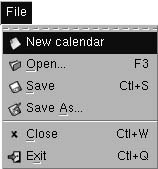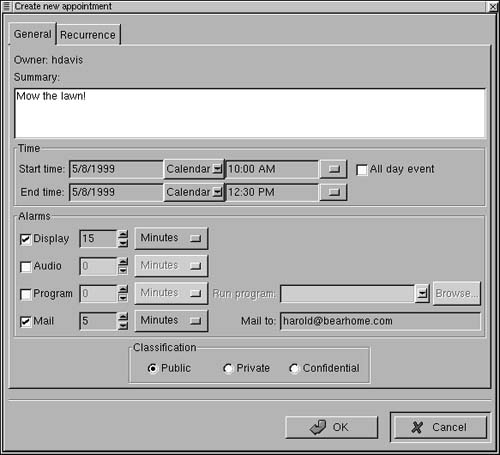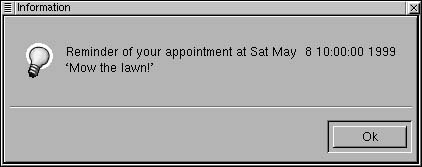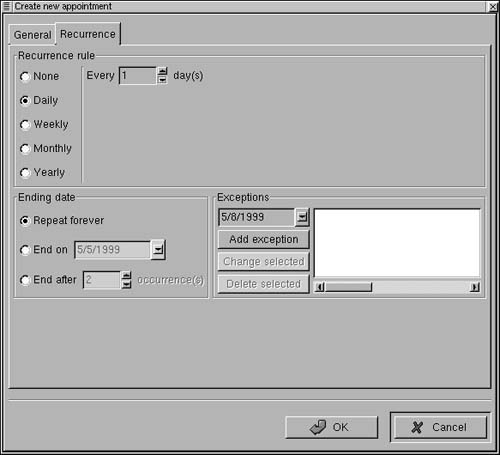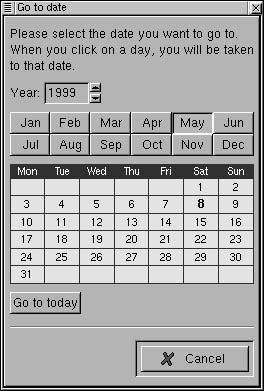Working with Gnome Calendar
Gnome Calendar—written by Miguel de Icaza, Federico Mena, and Arturo Espinosa—enables you to set up appointments, automate repeated items, and set alarms. You can view your calendar items on a daily, weekly, or monthly page—or you can review a year in a single screen.
Figure 7.1. Gnome Calendar can be used to keep track of appointments and tasks.
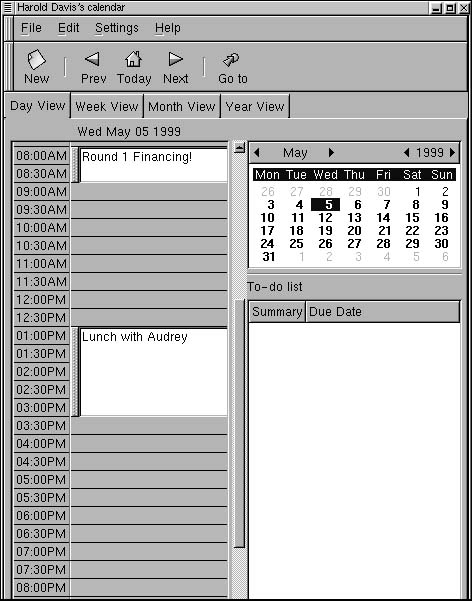
Linux is intended as a multiuser system. The expectation is that each user on the system will have his or her own files, configuration, and applications. In keeping with this philosophy, each user has a calendar. By default, the calendar is named using the full name supplied when the user was added to the system: for example, Harold Davis's calendar. (For information on adding users with the Red Hat Linux control panel, see Chapter 6.) In addition to your default calendar, you can save multiple calendars of your own.
To open Gnome Calendar:
-
With the Gnome desktop running, select Calendar from the Applications menu fly-out on the Gnome main menu. The Calendar will open (Figure 7.1).
To change Gnome Calendar to a 12-hour format:
1. | With Gnome Calendar open, choose Preferences from the Settings menu.The Preferences dialog box will open (Figure 7.2). Figure 7.2. You can use the Gnome Calendar Preferences dialog box to configure the display of calendar pages.
|
2. | Click OK or Apply. Then close the dialog box. |
To create a new appointment:
1. | Click New on the Calendar toolbar. The Create new appointment dialog box will open (Figure 7.3). Figure 7.3. The Create New Appointment dialog box is used to enter a calendar item.
|
2. | In the Summary box, enter a description of the item as you want it to appear in your calendar. |
3. | In the Time frame, enter a start date and time and an end date and time. You can enter dates and times using the keyboard or by clicking the Calendar and Time buttons. |
4. | If you want an event to be scheduled for an entire day, select the All Day Event box. |
5. | If you want an event to trigger an alarm, check the box for the alarm type you want. Select Display to display a message, Audio to play a sound, Program to run a program, or Mail to send email to the address you designate. |
6. | Click OK. If you configured an alarm, it will be triggered at the time you specified. Figure 7.4 shows a display alarm in action. Figure 7.4. You can configure calendar events to trigger alarms, such as the display shown (other alarms play a sound, run a program, or automatically send email).
|
To delete an appointment:
1. | With Gnome Calendar open to a page displaying the appointment, right-click the appointment you want to delete. |
2. | Select Delete This Appointment from the fly-out menu. |
Tip
If the appointment is one that recurs, you will be asked if you want to delete all instances of the appointment or just this appointment.
Recurring appointments
A recurring appointment is one that is automatically entered at the designated time in your calendar. For example, you might want to change backup tapes every day.
To enter a recurring appointment:
1. | Open the Create New Appointment dialog box and enter the information for the appointment item on the General tab (Figure 7.5). Figure 7.5. To create a recurring appointment, first create a one-time instance of the appointment item.
|
2. | Click Recurrence. The Recurrence tab will open (Figure 7.6). Figure 7.6. Use the Recurrence tab to set when and for how long an item appears in your calendar.
|
3. | Use the controls on the Recurrence tab to set how often you want the item to be added, when you want the item to stop being added, and whether there are any exceptions to your rules. An example of an exception would be adding a task every day except February 14. |
4. | Click OK. |
To go to a particular date:
1. | Click the Go To button on the Calendar toolbar. The Go To Date dialog box will open (Figure 7.7). Figure 7.7. You can use the Go To Date dialog box to open a specific date in your calendar.
|
2. | Select a year, month, and day. When you click a date, you will be taken to the calendar page for that date. |
Tip
To go to the current day, click the Go To Today button.
To view all your appointments for a week:
-
Choose the Week View tab in the Gnome Calendar main window. The Week View display will open (Figure 7.8).
Figure 7.8. You can use the View tabs to select Daily, Weekly, Monthly, or Yearly views.
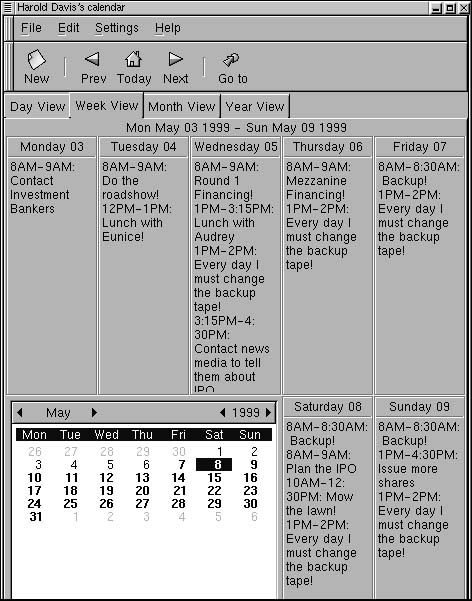
Tip
You can also select Month View or Year View to open the corresponding views.
To save your calendar:
-
Choose Save from the Gnome Calendar main menu.
Tip
To save a calendar that is different from the one created for you by default, select Save As from the File menu and give the calendar a name (Figure 7.9).
Figure 7.9. You can save multiple calendars, but the calendar created for your user ID will open by default.
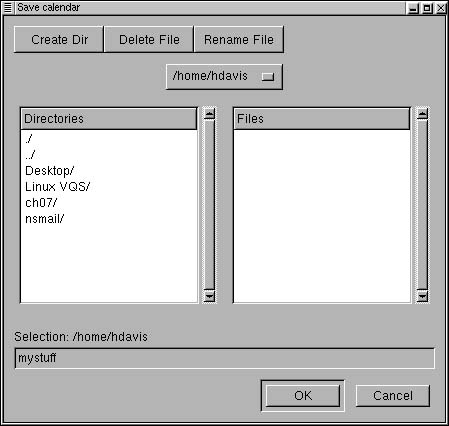
To start a new calendar:
-
Select New from the Gnome Calendar File menu (Figure 7.10).
Figure 7.10. To open a new calendar, select New from the File menu.
